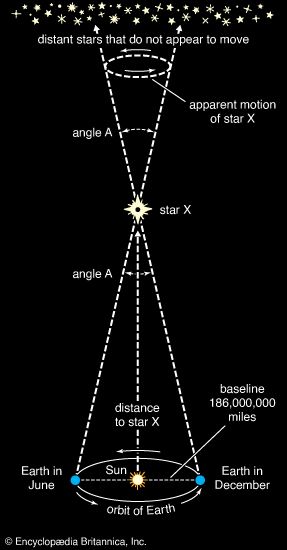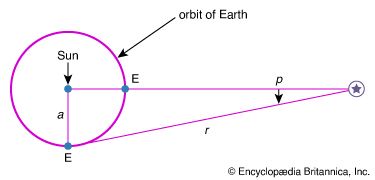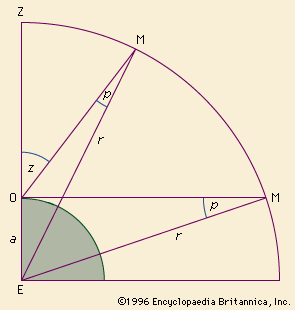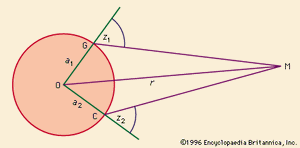parallax
parallax, in astronomy, the difference in direction of a celestial object as seen by an observer from two widely separated points. The measurement of parallax is used directly to find the distance of the body from Earth (geocentric parallax) and from the Sun (heliocentric parallax). The two positions of the observer and the position of the object form a triangle; if the base line between the two observing points is known and the direction of the object as seen from each has been measured, the apex angle (the parallax) and the distance of the object from the observer can be found simply.
In the determination of a celestial distance by parallax measurement, the base line is taken as long as possible in order to obtain the greatest precision of measurement. For the Sun and Moon, the base line used is the distance between two widely separated points on Earth; for all bodies outside the solar system, the base line is the axis of Earth’s orbit. The largest measured stellar parallax is 0.75″, for the nearest star, Alpha Centauri; the smallest that can be directly measured is about 25 times smaller, but indirect methods discussed below permit calculation of the parallax, inversely proportional to the distance, for more and more distant objects but also with more and more uncertainty.
The parallax of the Sun or Moon is defined as the difference in direction as seen from the observer and from Earth’s centre. If O is the observer on the surface of Earth, E the centre of Earth, and M the position of the Moon, then the angle OME is the parallax. This varies with the altitude of the Moon. If the Moon is directly overhead, the parallax is zero, and parallax is greatest when the body is on the horizon. With an angular distance z from the zenith, Z, it can be found from the triangle OME that sin p = a/r sin z. When z = 90°, sin p = a/r, and this value is called the horizontal parallax or, briefly, the parallax. For all bodies except the Moon, p is so small that it does not differ appreciably from sin p, and it is usually expressed in angular measure. The definitions of lunar and solar parallax must be further refined because of the spheroidal figure of Earth. The numerical values generally given are those of the equatorial horizontal parallax. The solar parallax is usually derived from measurements of the positions of other bodies of the solar system.
Lunar parallax
The first parallax determination was for the Moon, by far the nearest celestial body. Hipparchus (150 bce) determined the Moon’s parallax to be 58′ for a distance of approximately 59 times Earth’s equatorial radius, as compared with the modern value of 57′02.6″—that is, a mean value of 60.2 times. Lunar parallax is directly determined from observations made at two places, such as G, Greenwich, Eng., and C, the Cape of Good Hope, that are nearly on the same meridian. Angles z1 and z2 are observed, and other data are obtained from the latitudes of the observatories and the known size and shape of Earth. In practice, stars near the Moon are observed also to eliminate errors of refraction and instruments.
Another method rests on a comparison of the force of gravity at Earth’s surface with its value at the Moon. If M and m are the masses of Earth and the Moon, r the mean distance, P the sidereal period of revolution of the Moon about Earth, and G the constant of gravitation, G(M + m) = 4π2r3/P2 where π = 3.14. Also, g, the value of gravity at the Earth’s surface, determined from pendulum observations, is equal to GM/a2. Hence

As the quantities on the right-hand side are known with great accuracy, a/r is accurately determined as 57′2.7″.
Radar and laser measures of the distance from Earth to the Moon have provided a recent value of the lunar parallax. Radar and laser ranges have the advantage of being a direct distance measure, although the ranges are affected by variations in the surface topography of the Moon and require assumptions about the lunar radius and the centre of mass. The International Astronomical Union in 1964 adopted a value of 57′02.608″ for the lunar parallax corresponding to a mean distance of 384,400 km (238,900 miles).



















